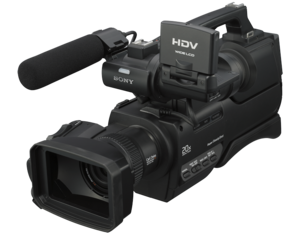Sony HVR-HD1000E
There were at one time four of these - only one of these continues to work, but doesn't record to tape.
They (used to) record at 1440x1080i50 (anamorphic) onto HDV tape for capture, and do live video out over HDMI or Composite. They have a good set of functions, setup by a touch screen and controlled during use by buttons and a fly-by-wire ring. Whilst the two newer Panasonic AG-AC90s are preferred for nearly everything, the remaining HVR still sees regular use as the third HD studio camera and usually hosts the autocue.
The original three cameras - and the associated tripod, lamp, wired remote control, and bag - were bought in 2009 with money from the Alumni Fund.
HD requires the use of battery converters to work with BNC cabling.
Power
These camera's are picky in that they need 8.7V through a propriety connector. There is an adapter cable-tied to each camera to allow the use of 4-pin XLR to provide power. However, care must be taken to avoid plugging a 12V supply into the camera's. Doing this turns the camera into a 'tape muncher', among other problems.
In February 2014, new power standards were introduced to combat this issue. The camera power supplies have been modified such that 8.4V and 12V are provided on different pins, hopefully preventing any more accidents.
Current Situation
Due to the use of incompatible power supplies (see above), the working HVR is a 'tape muncher'. As of March 2014, the camera could no longer be used for analogue SD shows. As of 2019 the camera is still in very occasional use, only as a last resort when all other cameras are used or in use ( like Roses ). It is unlikely that tape muncher JR will survive much longer without some bodging.
Historical
During their use at Woodstock 2009, the video out and umbilical were dangling directly from the composite socket for some of the show. The weight of the umbilical and the movement of the camera damaged the composite sockets of two of the cameras. These were re-soldered to the circuit board in the Easter vacation of 2010, but were damaged further in later years.
In February 2011, one the cameras was given an incorrect 12V power supply. This fried the main circuit board, resulting in the camera no longer powering on. It was replaced by a new HVR in October 2011. This incident was later repeated, resulting in another camera being unable to record to tape. This camera became known as 'Tape muncher'.
Due to wear, the mic jack on the third of the original cameras became intermittent, rendering the camera useless for audio recording.
On 10/06/13, during an ambitious evening of back-to-back live shows, a 12V power supply was accidentally plugged into the camera which was still capable of sound. Repairs were made to the camera, but it too became a 'tape muncher' (and was henceforth known as 'Tape muncher jr' to differentiate the cameras).
On 31/10/13, the jack on the 'no sound' camera was repaired, providing YSTV with a fully functioning camera again.
On 25/11/13, the fully functioning camera mysteriously ceased functioning just before a live show - despite the fact it had come straight from a shoot where it worked fine. The cause of the failure was not found, and meant YSTV had no HD cameras capable of recording.
On 18/06/14, just three days before Woodstock 2014, the 'Tape muncher' camera failed in similar circumstances. As these were the other two original cameras brought in 2009, it is possible that they failed due to age. If so, 'Tape muncher jr' (the remaining HVR) may possibly last another year or two at most.
2019, Tape muncher jr is still functional but has been mothballed other than occasional use.
Repair notes
Composite socket
In order to resolder the composite socket it is necessary to take off the side of the camera which has the speaker in - i.e. the side which rests against your face in shoulder-mounted operation. This requires removing four large screws on the large panel, the shoulder rest, two screws under the shoulder rest, one screw near the front of the camera on its base, one small one slightly on the right-hand side of the top of the lens, and one small one on the left hand side underneath the lens.
